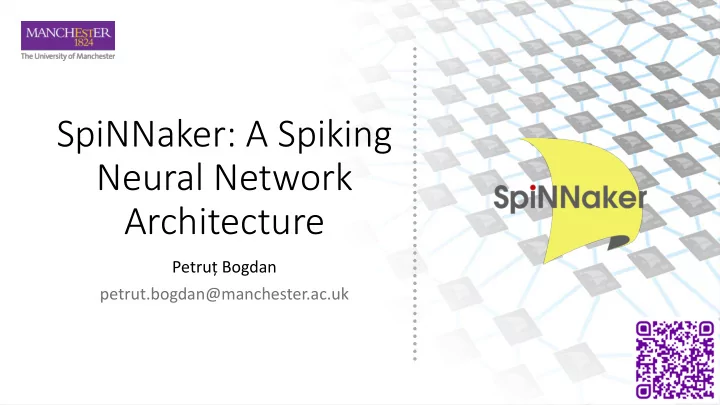

SpiNNaker: A Spiking Neural Network Architecture Petru ț Bogdan petrut.bogdan@manchester.ac.uk
Bio-inspiration Can massively-parallel computing resources accelerate our understanding of brain function ? Can our growing understanding of brain function point the way to more efficient parallel, fault- tolerant computation ? Chapter 1: Origin
Chip resources Chapter 2: The SpiNNaker Chip
SpiNNaker Multicast routing Chapter 2: The SpiNNaker Chip
SpiNNaker machines SpiNNaker board HBP platform • (864 ARM cores) – 1M cores – 11 cabinets (including server) Launch 30 March 2016 • – then 500k cores 112 remote users – 6,103 SpiNNaker jobs run – SpiNNaker chip (18 ARM cores) SpiNNaker racks (1M ARM cores) Chapter 3: Building the SpiNNaker Machines
Application range Computational Neuroscience Simulation Theoretical Neurorobotics Neuroscience Chapter 5: Applications – Doing Stuff on the Machine
Focus: structural plasticity for motion detection Bogdan et. al (2019, EMiT Conference) Chapter 7: Learning in neural networks Bogdan (2019, Thesis)
Intuition
Intuition Homogenous delays
Intuition Heterogeneous delays
Structural plasticity in the wild
Summary • Building neuromorphic hardware to make computation more efficient , and to advance our understanding of the brain • SpiNNaker is a 1-million ARM core digital neuromorphic machine currently in use to explore theoretical and computational neuroscience simulations and neurorobotics applications • Various models of synaptic and structural plasticity are and can be implemented on this platform; digital substrate offers flexibility in exchange for efficiency • Structural plasticity is a cool learning mechanism that can be used to grow synapses with different synaptic delays to optimize neuron responses to movement
Thank you! @pabmcr petrut.bogdan@manchester.ac.uk
Recommend
More recommend